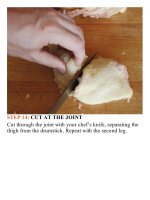The food lab better home cooking through science ( PDFDrive ) 411
Bạn đang xem bản rút gọn của tài liệu. Xem và tải ngay bản đầy đủ của tài liệu tại đây (131.78 KB, 2 trang )
Really,that’saboutallyouneedtoknow,soyou
have full permission to skip the rest of this sidebar
rightnow.Butforthoseofyouwho,likeme,hadthe
greatest geometry teacher in the world in ninth
grade and were thus instilled with a preternatural
desire to draw triangles and measure stuff, well, in
the words of Mr. Sturm, get your gas masks,
because we are climbing Mount Elegance, and the
airupthereisquitethin!
Quantitatively, how much of an effect does the
way you slice a steak actually have? Let’s set up
somedefinitions:
•Letwbethedistanceyoumovetheknifebetween
slices(i.e.,thewidthofaslice).
•Letmbethelengthofthemeatfibersineachslice.
•Finally,letθbetheanglebetweentheknifeblade
andthemeatfibers.
Given a bit of high school trigonometry, you can
quicklycomeupwiththefollowingformula:
m=w/sin(θ)
So,whataretheimplicationsofthis?Well,ifour
goalistominimizethelengthofthemeatfibers(m),
then we need to maximize sin(θ).When the meat is
cut into 0.5-inch strips at a 90-degree angle to the
directionofthemeatfibers,sin(θ)isequalto1(i.e.,
maximized) and the meat fibers are exactly as long
as the slice is wide, i.e., 0.5 inch. Cut them at a 45degreeangleinstead,andwhiletheirwidthisstill0.5
inch,thelengthofthemeatfibershasreached0.707
inch(that’sthesquarerootof0.5,forallyounerds
out there who get excited over 45°–45°–90° right
triangles).That’s an increase of almost 50 percent!
Now take it to the extreme: if you were to cut
perfectly parallel to the meat fibers, then sin(θ) will
beequalto0and,accordingtotheunbreakablelaws
of mathematics, your meat fibers would stretch all
thewayintoinfinity.That’sonebigcow!









